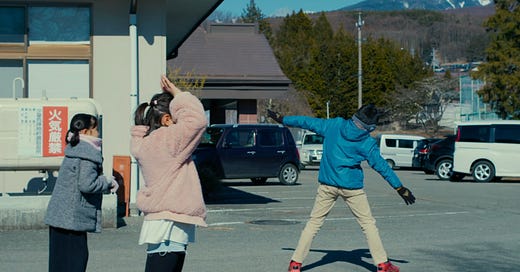Ryusuke Hamaguchi’s Evil Does Not Exist (2023) feels simple and straightforward visually with its characteristic long takes and naturalistic, almost documentary vibe. And yet, like the plot itself, this understated simplicity is deceptive. In a key scene, Takumi arrives late at his daughter’s, Hana’s, school to pick her up, and is told that she decided to walk home, assuming her father had forgotten to come get her. The scene unfolds with a lateral tracking shot as Takumi arrives, followed by a cut to a two shot (at :26, below) of a short exchange between Takumi and one of the teachers.
What we don’t realize is that the camera is actually now inside the car, although there is a gentle hint of this at the :38 second mark as a slight “bump” as Takumi—off screen—gets back in the car. Only when he begins driving away do we realize that the previous cut was not simply a repositioning of the camera from one point of view in the parking lot (the beginning of the clip, below) to another point of view in the parking lot (:26) but rather to an entirely different space: the inside of his car.
“Careful, I’m backing up,” he says, to the teacher (in the world of the film) and perhaps to us (in the world of the audience), a clue for us embedded in the narrative world of the film itself. I remember watching Evil Does Not Exist for the first time and not noticing this moment of clandestine editing, as I was immersed in the slowly building narrative tension of the drama of a potentially missing child. As Takumi drives away the past recedes, unrecoverable, the children—whom Hana will never join again—grow smaller and eventually disappear.
In an interview at Film Comment, Hamaguchi said that “ultimately, I am creating dramas that are close to reality in a way—I want to think about why people act the way they do and depict that as closely as possible to reality. But the camera positions I use also create a sort of fiction, and there is a contradiction that exists between these two ideas.” There’s a kind of radical intentionality to the editing in Evil Does Not Exist, radical for the fact that it feels unintentional. Like the films of his mentor, Kiyoshi Kurosawa, many of Hamaguchi’s films operate on a wavelength that, for lack of a better phrase, might be characterized as a kind of harmonized dissonance.
Balance, and disorder.
A generally calm, observant camera-as-narrator. And the camera as fiction in the “Where’s Hana?” scene, so immaculately staged that it doesn’t feel staged at all.








